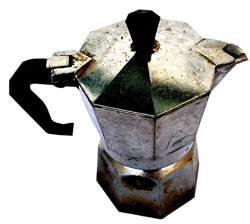 |
If you've wanted to ditch instant coffee but found load-shedding rendered your fancy electric coffeemaker as useful as a one-armed juggler, Richard Bull is here to the rescue.
Bull has just introduced the macchinetta, also known as the caffettiera, moka pot, or simply the coffee pot, to Kathmandu. His mission: to change the way we drink coffee. "A lot of coffee served is not good," he says. "It's bitter, flavourless, burnt, chemical, too strong, too watery, served in buckets, old, cold..."
While trekking in Langtang, Bull found every hotel, no matter how small or grand, was serving exactly the same instant coffee. He couldn't help but wonder: "Why does no one serve fresh Nepali coffee?" One lodge owner wanted to give his coffee pot idea a try. But since none were available in Kathmandu, Bull imported them himself. It took him over nine months to bring in a couple of hundred coffee pots.
"There is pretty good coffee available in Nepal," Bull says. "A small coffee pot means everyone can enjoy this locally produced, internationally sought after stuff."
Coffee pots are on sale at Cafe Society and Gaia Cafe.
Bull's instructions for making tasty coffee using moka pot
Its a bit more tricky that making instant coffee and this is part of the fun. Stick to some simple rules though and all will be well.Fill the bottom with water: Fill up to the pressure release valve and not above it. And advanced tip is to use hot water as this means the whole process happens faster and the coffees flavour is not degraded by too much exposure to heat. It also helps the rubber seal last longer. Don't burn your fingers though.
Use some good coffee: Freshly ground is best. Grind quite finely. If you grind too finely, then you will see sludge in the bottom of your cup so next time grind a little bit more coarsely. If you use pre-ground coffee, always reseal the pack tightly and put in the fridge after use. There is some great Nepali coffee around - at least it tastes good if you follow these instructions.
Fill the basket with coffee: Spoon it in and flatten off with a knife (or finger, or handle of spoon). Don't pack it down - when the water comes through it will expand and hamper the mixing of water and coffee. Always fill the basket - don't do less than full as your resultant coffee won't taste as good! Better to find someone to share the excess with.
Screw the top on tightly and place on the heat: Place on a medium to high flame so that the water boils quickly and the coffee is not over heated - but make sure the flame doesn't rise up around the sides of the pot either. After a few minutes, you'll hear a nice gurgle which means the water is just about used up in the bottom part. Give it another few seconds and remove from the heat. If you leave the pot on the heat, the coffee may start to boil and will taste awful. Overheating also can damage the rubber seal.
Pour into nice pre-warmed cups: Serve. You may want to serve as espresso or whisk some hot milk in a pan to make your own capuccino. That's up to you.
Make some appreciative sounds like 'mmmm' and enjoy!
Always wash your coffee pot with warm water and a soft cloth to remove oily residues from the coffee otherwise these will affect the taste of your next brew. Don't scrub! Don't use more than a tiny drop of soap! It's good to keep the protective dull layer on the inside of the pot. A shiny, shiny pot might give a metallic taste.
More tips at www.coffeepotnepal.com
READ ALSO:
Beans to brew- FROM ISSUE #490 (19 FEB 2010 - 25 FEB 2010)


